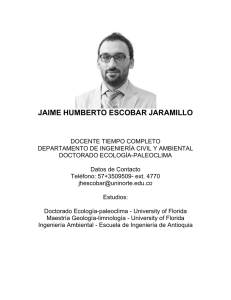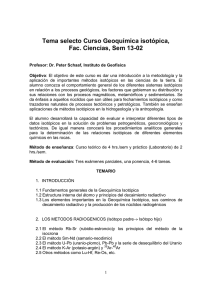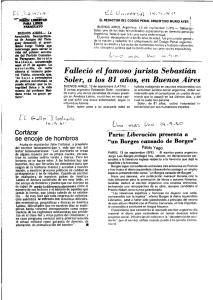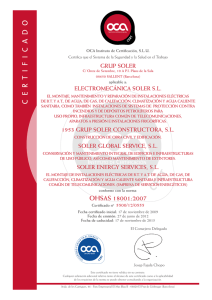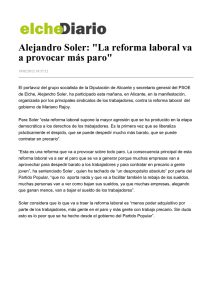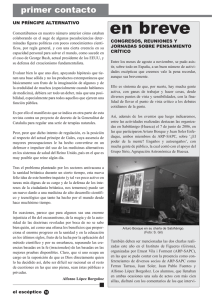BIBLIOGRAFIA
Anuncio
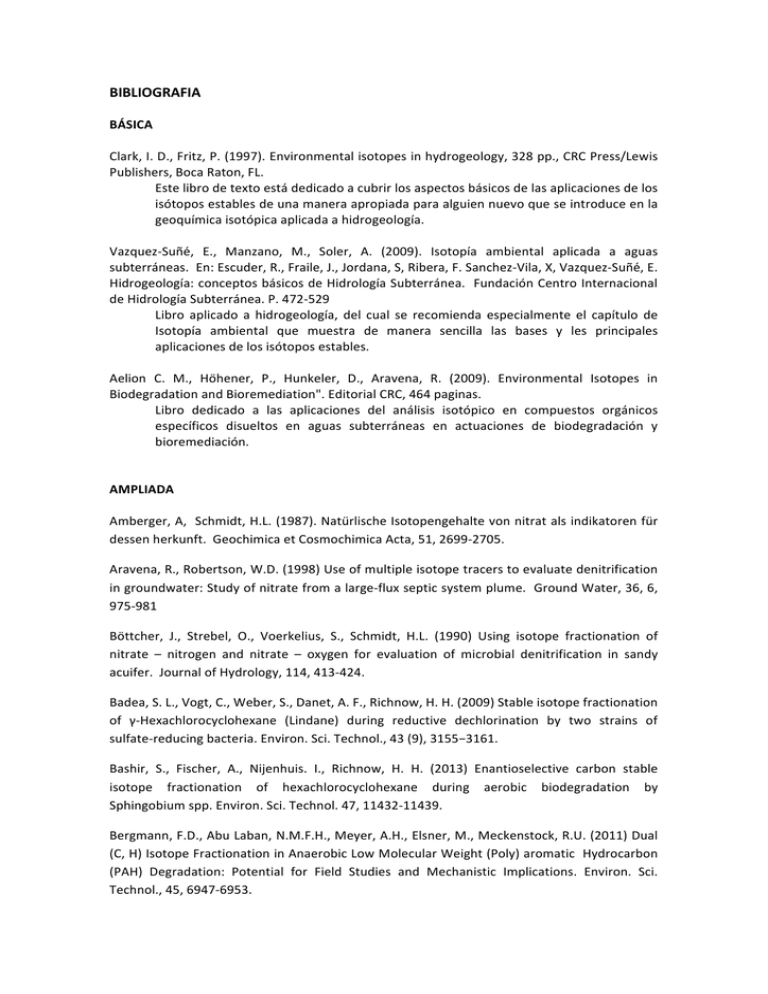
BIBLIOGRAFIA BÁSICA Clark, I. D., Fritz, P. (1997). Environmental isotopes in hydrogeology, 328 pp., CRC Press/Lewis Publishers, Boca Raton, FL. Este libro de texto está dedicado a cubrir los aspectos básicos de las aplicaciones de los isótopos estables de una manera apropiada para alguien nuevo que se introduce en la geoquímica isotópica aplicada a hidrogeología. Vazquez-­‐Suñé, E., Manzano, M., Soler, A. (2009). Isotopía ambiental aplicada a aguas subterráneas. En: Escuder, R., Fraile, J., Jordana, S, Ribera, F. Sanchez-­‐Vila, X, Vazquez-­‐Suñé, E. Hidrogeología: conceptos básicos de Hidrología Subterránea. Fundación Centro Internacional de Hidrología Subterránea. P. 472-­‐529 Libro aplicado a hidrogeología, del cual se recomienda especialmente el capítulo de Isotopía ambiental que muestra de manera sencilla las bases y les principales aplicaciones de los isótopos estables. Aelion C. M., Höhener, P., Hunkeler, D., Aravena, R. (2009). Environmental Isotopes in Biodegradation and Bioremediation". Editorial CRC, 464 paginas. Libro dedicado a las aplicaciones del análisis isotópico en compuestos orgánicos específicos disueltos en aguas subterráneas en actuaciones de biodegradación y bioremediación. AMPLIADA Amberger, A, Schmidt, H.L. (1987). Natürlische Isotopengehalte von nitrat als indikatoren für dessen herkunft. Geochimica et Cosmochimica Acta, 51, 2699-­‐2705. Aravena, R., Robertson, W.D. (1998) Use of multiple isotope tracers to evaluate denitrification in groundwater: Study of nitrate from a large-­‐flux septic system plume. Ground Water, 36, 6, 975-­‐981 Böttcher, J., Strebel, O., Voerkelius, S., Schmidt, H.L. (1990) Using isotope fractionation of nitrate – nitrogen and nitrate – oxygen for evaluation of microbial denitrification in sandy acuifer. Journal of Hydrology, 114, 413-­‐424. Badea, S. L., Vogt, C., Weber, S., Danet, A. F., Richnow, H. H. (2009) Stable isotope fractionation of γ-­‐Hexachlorocyclohexane (Lindane) during reductive dechlorination by two strains of sulfate-­‐reducing bacteria. Environ. Sci. Technol., 43 (9), 3155−3161. Bashir, S., Fischer, A., Nijenhuis. I., Richnow, H. H. (2013) Enantioselective carbon stable isotope fractionation of hexachlorocyclohexane during aerobic biodegradation by Sphingobium spp. Environ. Sci. Technol. 47, 11432-­‐11439. Bergmann, F.D., Abu Laban, N.M.F.H., Meyer, A.H., Elsner, M., Meckenstock, R.U. (2011) Dual (C, H) Isotope Fractionation in Anaerobic Low Molecular Weight (Poly) aromatic Hydrocarbon (PAH) Degradation: Potential for Field Studies and Mechanistic Implications. Environ. Sci. Technol., 45, 6947-­‐6953. Bernstein, A., Shouakar-­‐Stash, O., Ebert, K., Laskov, C., Hunkeler, D., Jeannottat, S., Sakaguchi-­‐ Söder, K., Laaks, J., Jochmann, M. A., Cretnik, S., Jager, J., Haderlein, S. B., Schmidt, T. C., Aravena, R., Elsner, M. (2011) Compound-­‐Specific Chlorine Isotope Analysis: A Comparison of Gas Chromatography/Isotope Ratio Mass Spectrometry and Gas Chromatography/Quadrupole Mass Spectrometry Methods in an Interlaboratory Study. Anal. Chem., 83, 7624–7634. Chartrand, M.M.G., Hirschorn, S.K., Lacrampe-­‐Couloume, G., Sherwood Lollar, B. (2007) Compound-­‐specific hydrogen isotope analysis of 1,2-­‐dichloroethane: potential for delineating source and fate of chlorinated hydrocarbon contaminants in groundwater Rapid Commun. Mass Spectrom. 21, 1841–1847. Claypool, G.E., Holser, W.T., Kaplan, I.R., Zak, I. (1980) The age curves of sulfur and oxygen isotopes in marine sulfate and their mutual interpretation. Chemical Geology, 28, 199-­‐260. Craig, H. (1961). "Isotopic variations in meteoric waters". Science, 133, 1702-­‐1703. Elsayed, O.F., Maillard, E., Vuilleumier, S., Nijenhuis, I., Richnow, H.H., Imfeld, G. (2014). Using compound-­‐specific isotope analysis to assess the degradation of chloroacetanilide herbicides in lab-­‐scale wetlands. Chemosphere. 99, 89-­‐95. Fischer A., Herklotz I., Herrmann S., Thullner, M., Weelink, S.A.B., Stams A.J.M., Schlömann, M., Richnow H.H.,, Vogt C. (2008) Combined Carbon and Hydrogen Isotope Fractionation Investigations for Elucidating Benzene Biodegradation Pathways. Environ. Sci. Technol., 42, 4356–4363 (http://pubs.acs.org/doi/abs/10.1021/es702468f) Fritz P., Basharmal G. M., Drimmie R. J., Ibsen J., and Qureshi R. M. (1989) Oxygen isotope exchange between sulfate and water during bacterial reduction of sulfate. Chem. Geol. 79, 99– 105.Gilevska, T., Gehre, M.and Richnow, H. H. (2014) Performance of the Wet Oxidation Unit of the HPLC Isotope Ratio Mass Spectrometry System for Halogenated Compounds. Anal. Chem. 86, 7252−7257. Gonfiantini, R., Araguas, L. (1988) Los Isótopos Ambientales en el Estudio de la Intrusión Marina. TIAC'88. Tecnología de la Intrusión en Acuíferos Costeros Almuñécar (Granada, España). P. 136-­‐190. Heaton, T.H.E. (1986) Isotopic studies of nitrogen pollution in the hydrosphere and atmosphere: a review. Chemical Geology (Isotope Geoscience Section), 59, 87-­‐102. Huang, L., Sturchio, N.C., Abrajano, T. Jr., Heraty, L.J., Holt, B.D. (1999) Carbon and chlorine isotope fractionation of chlorinated aliphatic hydrocarbons by evaporation., Organic Geochem., 30, 777-­‐785. Hunkeler, D., Aravena, R., Butler, B.J. (1999) Monitoring microbial dechlorination of Tetrachloroethene (PCE) in groundwater using compound-­‐specific stable carbon isotope ratios: microcosm and field studies. Environmental Science and Technology, 33, 2733 – 2738 Hunkeler, D., R. U. Meckenstock, B. Lollar, T. C. Schmidt, Wilson, J. T. (2009) A Guide for Assessing Biodegradation and Source Identification of Organic Groundwater Contaminants Using Compound Specific Isotope Analysis (CSIA). U.S. Environmental Protection Agency, Washington, D.C., EPA/600/R-­‐08/148. http://cfpub.epa.gov/si/si_public_record_Report.cfm?dirEntryId=202171&CFID=12071441&CF TOKEN=46474245 Ivdra, N., Herrero-­‐Martín, S., Fischer, A. (2014) Validation of user-­‐ and environmentally friendly extraction and clean-­‐up methods for compound-­‐specific stable carbon isotope analysis of organochlorine pesticides and their metabolites in soils, J. Chromatogr. A. 1355, 36-­‐45. Kujawinski, D.M., Wolbert, J.B., Zhang, L., Jochmann, M.A., Widory, D., Baran, N., Schmidt, T.C. (2013) Carbon isotope ratio measurements of glyphosate and AMPA by liquid chromatography coupled to isotope ratio mass spectrometry, Anal. Bioanal. Chem. 405, 2869-­‐2878. Kuder, T., Van Breukelen, B. M., Vanderford, M., Philp, P. (2013) 3D-­‐CSIA: Carbon, Chlorine, and Hydrogen Isotope Fractionation in Transformation of TCE to Ethene by a Dehalococcoides Culture. Environ. Sci. Technol., 47, 9668−9677. Lambán, J., Custodio, E. (1999) Estudio isotópico ambiental (18O-­‐ δD) en la unidad Anoia: principales zonas de recarga e implicaciones en el funcionamiento hidrogeológico del sistema. Ingeniería del Agua. Vol. 6 Num.2, páginas 139-­‐150. Lucas, L. L., Unterweger, M. P. (2000) Comprehensive Review and Critical Evaluation of the Half-­‐Life of Tritium. Journal of Research of the National Institute of Standards and Technology Volume 105, Number 4, 541-­‐549. Meckenstock, R. U., Morasch, B., Griebler, C., Richnow, H. H. (2004) Stable isotope fractionation analysis as a tool to monitor biodegradation in contaminated aquifers J. Contam. Hydrol. 75, 215-­‐255. Meyer, A. H., Penning, H., Elsner, M. (2009) C and N isotope fractionation suggests similar mechanisms of microbial atrazine transformation despite involvement of different enzymes (AtzA and TrzN), Environ. Sci. Technol. 43, 8079–8085. Meyer, A. H., Elsner, M. (2013) 13C/12C and 15N/14N isotope analysis to characterize degradation of atrazine: evidence from parent and daughter compound values, Environ. Sci. Technol. 47, 6884−6891. Michel, R. L. (1989). Tritium deposition over the continental United States, 1953-­‐1983, In: Atmospheric Deposition, International Association of Hydrological Sciences, Oxford, UK. pp.105-­‐115. Otero, N., Soler, A.,, Canals, À. (2008). Controls on δ34S and δ18O in dissolved sulphate: learning from a detailed survey in the Llobregat River (Spain). Applied Geochemistry, 23, 1166-­‐1185. Otero, N., Canals, À., Soler, A. (2007). Using dual-­‐isotope data to trace the origin and processes of dissolved sulphate: a case study in Calders stream (Llobregat basin, Spain). Aquatic Geochemistry, 13, 109-­‐126. Otero N., Torrentó, C., Soler, A., Menció, A., Mas-­‐Pla, J. (2009). Monitoring groundwater nitrate attenuation in a regional system coupling hydrogeology with multi-­‐isotopic methods: the case of Plana de Vic (Osona, Spain).Agriculture Ecosystems and the Environment, V133, 103-­‐113. Palau, J., Cretnik, S., Shouakar-­‐Stash, O., Höche, M., Elsner, M., Hunkeler, D. (2014a) C and Cl Isotope Fractionation of 1,2-­‐Dichloroethane Displays Unique δ13C/δ37Cl Patterns for Pathway Identification and Reveals Surprising C−Cl Bond Involvement in Microbial Oxidation. Environ. Sci. Technol., 48, 9430−9437. Palau, J., Shouakar-­‐Stash, O. and Hunkeler, D. (2014b) Carbon and chlorine isotope analysis to identify abiotic degradation pathways of 1,1,1-­‐trichloroethane. Environmental science & technology 48(24), 14400-­‐14408. Pawels, H., Foucher, J.C., Kloppmann, W. (2000) Denitrification and mixing in a schist aquifer: Influence on water chemistry isotopes. Chemical Geology, 168, 307-­‐324. Penning, H., Sorensen, S. R., Meyer, A. H., Aamand, J., Elsner, M. (2010). C, N, and H Isotope fractionation of the herbicide isoproturon reflects different microbial transformation pathways, Environ. Sci. Technol. 44 (7), 2372-­‐2378. Plummer, L. N., Michel, R. L., Thurman, E. M. and Glynn, P. D. (1993). Environmental tracers for age dating young ground water, In: W.M. Alley (Ed.), Regional Ground-­‐Water Quarterly, V. N. Reinhold, New York. pp. 255-­‐294. Puig, R., Àvila, A., Soler, A. (2008). Sulphur isotopes as tracers of the influence of a coal-­‐fired power plant on a Scots pine forest in Catalonia (NE Spain). Atmospheric Environment, 42, 733-­‐ 745. Rosell, M., Gonzalez-­‐Olmos, R., Rohwerder, Rusevova, K., T., Georgi, A. Kopinke, F.D. and Richnow, H.H. (2012) Critical evaluation of the 2D-­‐CSIA scheme for distinguishing fuel oxygenate degradation reaction mechanisms. Environ. Sci. Technol., 46, 4757−4766. Seiler, R. L. (2005). Combined use of 15N and 18O of nitrate and 11B to evaluate nitrate contamination in groundwater. Applied Geochemistry. 20, 1626-­‐1636. Sherwood Lollar, B., Slater, G. F., Ahad, J., Sleep, B., Spivack, J., Brennan, M., MacKenzie, P. (1999) Contrasting carbon isotope fractionation during biodegradation of trichloroethylene and toluene: Implications for intrinsic bioremediation. Org. Geochem. 30, (8A), 813-­‐820. Schmidt, T. C., Zwank, L., Elsner, M., Berg, M., Meckenstock, R. U., Haderlein, S. B. (2004) Compound-­‐specific stable isotope analysis of organic contaminants in natural environments: a critical review of the state of the art, prospects, and future challenges. Anal. Bioanal. Chem. 378, 283-­‐300. Shouakar-­‐Stash, O., Drimmie, R.J. (2013). Online methodology for determining specific hydrogen isotope ratios of trichloroethene and 1,2-­‐cis-­‐dichloroethene by continuous-­‐flow isotope mass spectrometry. Rapid Com. Mass Spec., 27, 1335-­‐44. Slater G.F., E.A. Edwards, Sleep, B., Sherwood Lollar B. (2001) Variability in carbon isotopic fractionation during biodegradation of chlorinated ethenes: Implications for field applications. Environ. Sci and Technol. Vol. 35:901-­‐907. Van Stempvoort, D.R., Krouse, H.R. (1994) Controls on δ18O sulphate Review of experimental data and application to specific environments. In: Environmental Geochemistry of sulphide oxidation. Alpers C.N., Blowes D.W.A.C.S. (Eds). Symposium series 550, American Chemical Society, Washington, DC. P.446-­‐480. Vitòria, L, Otero, O, Soler, A., Canals, À. (2004) Fertilizer Characterization: Isotopic Data (N, S, O, C and Sr). Environmental Science & Technology, 38, 3254-­‐3262. http://www-­‐naweb.iaea.org/napc/ih/documents/userupdate/Waterloo/ Vitòria L., Soler A., Canals A. (2003) Uso de los isòtopos ambientales N,S,C,O) en la valoración de procesos de remediación natural de aguas contaminadas por nitratos, ejemplo de Osona (NE España). El agua y la ciudad sostenible: Hidrogeología urbana: 335-­‐341. Vitòria L., Soler A., Aravena R., Canals A. (2005) Multi-­‐isotopic approach 15N, 13C, 34S, 18O and D) for tracing agriculture contamination in groundwater (Maresme, NE Spain). In: Environmental Chemistry (Eds. E. Lichtfouse, J. Schwarzbauer and D. Robert). Springer-­‐Verlag, Heidelberg, 43-­‐56. Vitòria L., Soler A., Canals À., Otero N. (2008) Environmental isotopes (N, S, C, O, D) to determine natural attenuation processes in nitrate contaminated waters: example of Osona (NE Spain). Applied Geochemistry, 23, 3597-­‐3611 (2008). Available online at Science Direct. Wadleigh, M.A., Schwarcz, H.P., Kramer J.R. (1996) Isotopic evidence for the origin of sulphate in coastal rain. Tellus, 48B, 44-­‐59. Zwank, L., Berg, M., Schmidt, T. C., Haderlein, S. B. (2003) Compound-­‐specific carbon isotope analysis of volatile organic compounds in the low-­‐microgram per liter range. Anal. Chem. 75, (20), 5575-­‐5583. Zwank, L., Berg, M., Elsner, M., Schmidt, T. C., Schwarzenbach, R. P., Haderlein, S. B. (2005) New evaluation scheme for two-­‐dimensional isotope analysis to decipher biodegradation processes: Application to groundwater contamination by MTBE. Environ. Sci. Technol. 39 (4), 1018−1029. Van Stempvoort D.R., Reardon, P., Fritz E.J. (1990) Fractionation of sulfur and oxygen isotopes in sulfate by soil sorption. Geochimica et Cosmochimica Acta, Volume 54, Issue 10, p. 2817– 2826 Widory, D., Petelet-­‐Giraud, E., Négrel, P., Ladouche, B. (2005) Tracking the sources of nitrate in groundwater using coupled nitrogen and boron isotopes: a synthesis. Environmental Science and Technology. 39, 539-­‐548. Widory, D., Petelet-­‐Giraud, E., Brenot, A., Bronders, J., Tirez, K., Boeckx, P. (2013). Improving the management of nitrate pollution in water by the use of isotope monitoring: the δ15N, δ18O and δ11B triptych. Isotopes in Environmental and Health Studies. S. 48, 1-­‐19. WEB Sociedad Española de Mineralogía URL: http://www.ehu.eus/sem/seminario_pdf/SEMINARIO_SEM_1_Conten.pdf Diversos artículos sobre aplicaciones de isótopos de azufre, nitrógeno y carbono a la resolución de problemas ambientales de contaminación: Delgado, A., Reyes, E. (2004): Isótopos Estables como indicadores paleoclimáticos y paleohidrológicos en medios continentales. En L. Barbero y P. Mata (eds.), Geoquímica Isotópica aplicada al medioambiente, Seminarios de la Sociedad Española de Mineralogía, 1, 37-­‐53. Manzano, M., Soler, A., Carrera, J., Custodio, E. (2004): Estudio isotópico del origen del sulfato del agua subterránea en la zona afectada por el vertido minero de Aznalcóllar (SO España). En L. Barbero y P. Mata (eds.), Geoquímica Isotópica aplicada al medioambiente, Seminarios de la Sociedad Española de Mineralogía, 1, 71-­‐88. Otero, N., Soler, A. (2001) Los isótopos de azufre como trazadores de la influencia de la minería potásica en la salinización de las aguas subterráneas de la cuenca del Llobregat (NE España). In: A. Medina; J. Carrera i L. Vives (eds.): Las Caras del Agua Subterránea. Instituto Geológico y Minero de España. Serie Hidrogeología y Aguas Subterráneas: 421-­‐428 Palau, J., Canals, A., Soler, A. (2004): Los isótopos de carbono como trazadores del origen de compuestos eteno clorados y su utilización en el control de la atenuación. En L. Barbero y P. Mata (eds.), Geoquímica Isotópica aplicada al medioambiente, Seminarios de la Sociedad Española de Mineralogía, 1, 63-­‐69. Soler, A., Canals, A., Antich, N. (2004): La relación 87Sr/86Sr, una nueva herramienta medioambiental para trazar el origen de la contaminación: el ejemplo del río Cardener, cuenca del río Llobregat. En L. Barbero y P. Mata (eds.), Geoquímica Isotópica aplicada al medioambiente, Seminarios de la Sociedad Española de Mineralogía, 1, 89-­‐96.N. Vitoria, L., Soler, A., Canals, A. (2004): Uso de los isótopos ambientales (N, S, C, O) en la determinación del papel de las piritas como catalizadoras de procesos de atenuación natural de aguas contaminadas por nitratos: ejemplo de Osona (NE España). En L. Barbero y P. Mata (eds.), Geoquímica Isotópica aplicada al medioambiente, Seminarios de la Sociedad Española de Mineralogía, 1, 55-­‐62.
